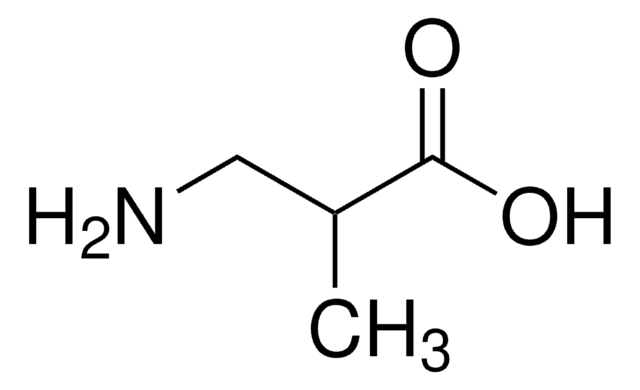M6531
15-Methylpalmitic acid
≥98% (capillary GC)
Synonym(s):
15-Methylhexadecanoic acid
Sign Into View Organizational & Contract Pricing
All Photos(1)
About This Item
Empirical Formula (Hill Notation):
C17H34O2
CAS Number:
Molecular Weight:
270.45
MDL number:
UNSPSC Code:
12352211
PubChem Substance ID:
NACRES:
NA.25
Recommended Products
Quality Level
Assay
≥98% (capillary GC)
form
powder
functional group
carboxylic acid
lipid type
saturated FAs
shipped in
ambient
storage temp.
2-8°C
SMILES string
CC(C)CCCCCCCCCCCCCC(O)=O
InChI
1S/C17H34O2/c1-16(2)14-12-10-8-6-4-3-5-7-9-11-13-15-17(18)19/h16H,3-15H2,1-2H3,(H,18,19)
InChI key
IIUXHTGBZYEGHI-UHFFFAOYSA-N
Signal Word
Warning
Hazard Statements
Precautionary Statements
Hazard Classifications
Eye Irrit. 2 - Skin Irrit. 2 - STOT SE 3
Target Organs
Respiratory system
Storage Class Code
11 - Combustible Solids
WGK
WGK 3
Personal Protective Equipment
dust mask type N95 (US), Eyeshields, Gloves
Regulatory Information
新产品
Choose from one of the most recent versions:
Already Own This Product?
Find documentation for the products that you have recently purchased in the Document Library.
Kyleann K Brooks et al.
PloS one, 4(10), e7545-e7545 (2009-10-22)
The nematode Caenorhabditis elegans has emerged as an important model for studies of the regulation of fat storage. C. elegans feed on bacteria, and various strains of E. coli are commonly used in research settings. However, it is not known
A A Aliero et al.
Journal of medicinal food, 10(3), 557-558 (2007-09-25)
The volatile components obtained by hydrodistillation of Solanum pseudocapsicum roots were analyzed by gas chromatography-mass spectrometry. A total of 41 compounds, representing 50% of the oil, were identified. The oil was found to contain fatty acids (26.8%), terpenoids (7.6%), and
Atsuko Matsumoto et al.
International journal of systematic and evolutionary microbiology, 57(Pt 11), 2651-2654 (2007-11-06)
Two novel actinomycete strains, KV-744T and KV-856, were isolated by long-term cultivation. Aerial long-chain spores were produced directly from vegetative mycelia and possessed no motility. Vegetative mycelia developed very well and exhibited fragmentation. The cell-wall peptidoglycan contained meso-diaminopimelic acid, glycine
Myung Soo Park et al.
International journal of systematic and evolutionary microbiology, 56(Pt 2), 433-438 (2006-02-02)
Two Gram-negative, yellow-pigmented bacteria designated PSD1-4T and PHA3-4T, isolated from two sand-dune plant species inhabiting coastal areas in Tae-an, Korea, were subjected to taxonomic investigation. 16S rRNA gene sequence analysis indicated that both isolates should be placed in the genus
Honoka Tanno et al.
Biochimica et biophysica acta. Molecular and cell biology of lipids, 1866(1), 158842-158842 (2020-10-19)
Although most mammalian fatty acids (FAs) are straight-chain, there also exist branched-chain FAs such as iso- and anteiso-FAs, especially in the meibomian glands. Meibum lipids, which are secreted from the meibomian glands and are important for dry eye prevention, contain
Our team of scientists has experience in all areas of research including Life Science, Material Science, Chemical Synthesis, Chromatography, Analytical and many others.
Contact Technical Service







